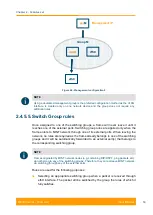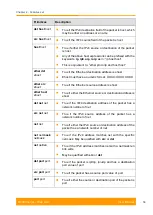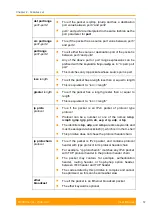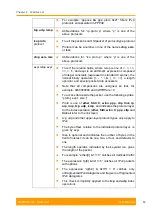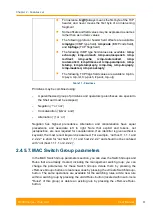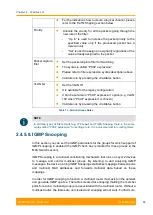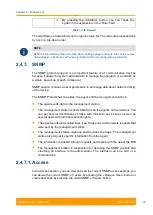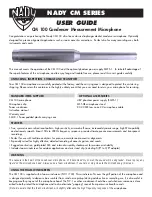
Chapter 2 - Features set
User Manual
R5000 series - Web GUI
65
For the indications how to create a logical channel, please
refer to the Traffic Shaping section below
Priority
Allocate the priority for all the packets going through the
new rule of the filter:
-
“Up to” is used to increase the packet priority to the
specified value only if the processed packet has a
lower priority
-
“Set” is used to assign a new priority regardless of the
value already assigned to the packet
Packet capture
filter
Set the packet capture filter for Switching
The syntax is
called “PCAP expression”
Please refer to filter expression syntax description above
Validate rule by pressing the «Validate» button
VLAN list
Set the VLAN ID
It is available for the legacy configuration
It can be set also in
“PCAP expression” option (e.g. VLAN
100 when
“PCAP expression” is chosen)
Validate rule by pressing the «Validate» button
Table 13 - Switch Groups Rules
NOTE
In all three types of filters: Switching, IP Firewall and Traffic Shaping, there is the same
syntax called “PCAP expression” for setting a rule. It is a universal tool for creating filters.
2.4.5.8. IGMP Snooping
In this section you can set the IGMP-parameters for the groups for which support of
IGMP snooping is enabled (the IGMP check box is marked for these groups in the
MAC Switch section).
IGMP Snooping is a multicast constraining mechanism that runs on Layer 2 devices
to manage and control multicast groups. By listening to and analyzing IGMP
messages, the device running IGMP Snooping establishes mappings between ports
and multicast MAC addresses and forwards multicast data based on these
mappings.
In order for IGMP snooping to function, a multicast router must exist on the network
and generate IGMP queries. The tables created for snooping (holding the member
ports for each a multicast group) are associated with the multicast router. Without a
multicast router, the tables are not created and snooping will not work. Furthermore,



